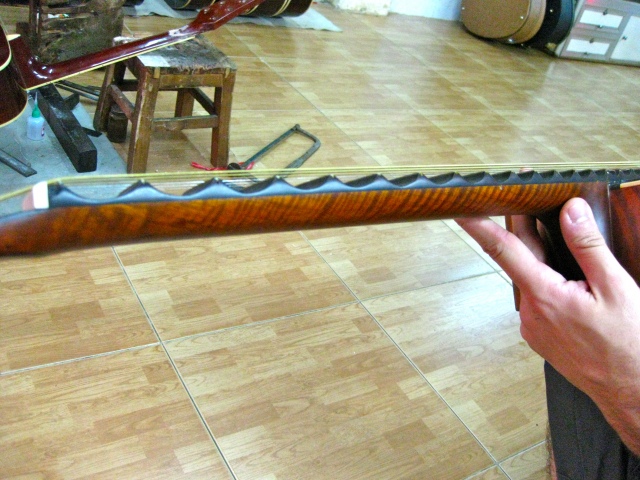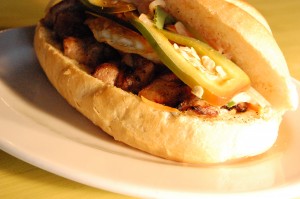Everyone’s talking about the upcoming Nam show, so I figured I should post something relevant. I’ve never been to Southeast Asia, though everyone I know who has loves the place. And I’ve been floored by the beauty and originality of those Vietnamese electric guitarists who scallop their fretboards not because they love Yngwie, but to replicate the wild swoops and expressive quavering of their indigenous folk instruments. Put it all through a cheap solid-state amp and vulgar digital reverb, and it’s…perfection.
I’m no expert on the style, so I turned to Scott Collins, who’s posted here a few times. He’s a dauntingly knowledgable player and teacher who runs an interesting site called Guitarchitecture. The centerpiece is a comprehensive guitar method he’s created that applies visual metaphors to the process of mastering the fretboard.
Anyway, Scott hastens to point out that he’s no expert on Vietnamese guitar either, yet he’s created a beautiful little piece on the topic. He visited Viet Nam with an eager ear, a respectful attitude, and keen powers of observation. You won’t be bored. —Joe
__________________________________________
Wild String Sounds from the Dan Bau and Vong Co
By Scott Collins
For me, you can’t talk about Vietnam without talking about Bánh mì Trung (egg sandwich). I went to Vietnam in 2010 to visit my wife who was working in Ho Chi Minh City. Every morning I was there, I got up early and ventured about 100 feet out of the hotel to a vendor who made the sandwiches on the street using a charcoal-heated skillet. For about .50 US I got a baguette with homemade mayo (or butter), jalapeño slices, pickled daikon and carrots, cucumber, a little soy sauce and fresh cooked eggs. A perfect marriage of form and function, the Bánh mì takes an element from its French occupation (French baguette) and adds a unique Vietnamese twist to it. It may be copied and sold here in the States, but it could have only come from Vietnam.
Like the bánh mì, traditional Vietnamese instruments and music owes a debt to outside influence (in this case China), but has taken it in a direction uniquely its own. Since the music of Vietnam is far too large of a topic to go into here, I wanted to address two stringed instruments in particular.
Dan Bau. The Dan Bau (also know as the Dan Doc Huyen) is a single-string instrument that consists of a sound box (about 30” or so and often having a great deal of decorative inlay) and a single string, which is strung between a guitar tuner on one end and a bamboo or horn pole and what looks like a little wooden bell on the other. Since there’s no fretboard, pitch changes come from plucking the string with a wooden plectrum and using the pole as a type of vibrato bar with combinations of the open string and harmonics (created by using the bottom part of the picking hand). Skilled players can create entire melodies this way!!
The Dan Bau is often heard playing western melodies (“Ghost Riders in the Sky” seems to be a favorite. Check out this divinely bizarre arrangement in the link below).
Since the instrument isn’t very loud, it’s often played through a megaphone, amplified loudspeaker or a small guitar amp producing something that sonically resembles Jeff Beck on acid.
And remember: The melody is played only on one string!
This next video features a guitar and Dan Bau duet playing a version of “Scarborough Fair.” Pham Duc Thanh ‘s phrasing (which features large, swooped pitch changes and very wide vibrato) is typical for the style.
Here you can see the Trang Ang Flowers ensemble playing a traditional piece with an updated arrangement. The Dan Bau in this video seems like much more of a folk instrument (using a single piece of unadorned bamboo for the body) than the previous example. But that doesn’t stop the performer from pulling out a breathtaking performance!
If the outrageous bass headstock doesn’t take up all of your attention, you can see the amplified speaker in the foreground acting as a PA for the ensemble.
You can find these on eBay in the $100-$200 range but for those of you with a DIY aesthetic, here’s a design for a very rough Dan Bau you could build on your own.
Vong co Guitar. Also called the Ghita (or Dan ghita) this guitar is often used to play cải lương or vong co music. It’s a style that blends classical music and folk songs in a unique way.
I’ve provided links below. While the videos below are more amateur in nature, they show off some cool features of the instruments.
Vong co guitars often have 5 strings in a pentatonic drop-C tuning and deep scalloping on the fretboard to facilitate large bends and wide vibrato.
Most of the electrics I saw for sale were Strat copies like this one. (Note the “Fender” logo on the headstock!) The performance starts around :26.
You’ll also see some Teisco variations like this one. Just try to sing back that melody!
I saw this exact guitar model on guitar street in Ho Chi Minh City. Each of the switches control pickups and often activate built in effects. Sometimes this is chorus or octave, but I played one with a built in ring modulator that was just wild. The guitar was only about $100, but without a case I really had no way to get it back to the States in one piece.
Here’s an acoustic version similar to the instrument in the picture above. This is a nylon top attached to a interlaced body. The build quality is usually inexpensive and the sound is often very tinny.
These were around $125-150 in the shops there.
When I took the Tam Hiep acoustic I bought in Vietnam to a repair person in Southern California to install some new tuners, his memorable quote was, “Oh I’ve seen some of the guitars that come out of there. Those builders really aren’t afraid to just go for it.”
I humbly submit this wild double-neck version as evidence of some of the glorious excess of style you can find there.
Hopefully this has whetted your appetite and maybe given you a little inspiration for your phrasing. Here are some additional things to check out for those of you who want to persue this further.
Additional links:
There’s a block of guitar shops in Ho Chi Minh city where you can find cool factory and hand-built acoustic and electric guitars for a fraction of what they run in the states. Here’s a relevant article, as well as this 2011 post on Guitar Player’s blog.
Here’s more about the vọng cổ‘s history, tunings and theory:
Here’s a great overview on various Vietnamese music styes.
This page has instrument photos of stringed instruments in general, but the Vietnam section shows off the inlay.
____________________________________________________
Scott, that was killer! Thanks for making my posts look lazy and shabby such a great piece! I went cruising for clips and found . . . um . . . this. Well, you can’t argue with the visuals.
Please join me in thanking Scott for his fine work!










Super cool post Scott! Thanks for all the video’s and info. That is some very interesting stuff. I must admit when I saw that first picture of the fretboard I was thinking “Man they must love them some Yngwie!!!!” Thanks again!
and Joe…love that video you found there of the Godzilla looking guy playing the triple necked synthy version………WOW :oogle:
Very nice article. The attached videos are a real eye opener. Thanks for this intro to a world of music I was unfamiliar with.
Always good stuff from Scott! It’s cool to see what other humans around the planet manage to do with string!
Vive la baguette! That post is terrific!
Thanks for the kind words everyone!
(And special thanks to Joe for posting this!)
Awesome, I really enjoyed that very much!
Thanks fore posting this! Amazing fun stuff.